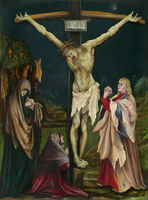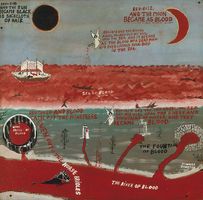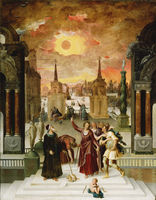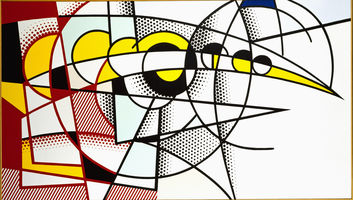"Solar Eclipse," from Zakariyya ibn Muhammad al-Qazwini
Ottoman Turkish
"Solar Eclipse," from Zakariyya ibn Muhammad al-Qazwini
ca. 1203–1283 (author) and Muhammad ibn Muhammad Shakir Ruzmah-'i Nathani (scribe), Turkish Book of the Wonders of Creation
1121 AH/AD 1717
Ink and pigments on European laid paper
Walters Art Museum W.659.13b
Decorative illustration accompanying the chapter on solar eclipse in an Ottoman Turkish version, written and illustrated in 1717, of a famous encyclopedia on natural history entitled 'Aja'ib al-makhluqat (Wonders of creation) composed in Arabic in the 13th century by al-Qazwini (1202-1283).
Al-Qazwini gathered for his encyclopedia well-established knowledge and presented it in a concise and well-organized form for a broad reading public. The information he provides on the solar eclipse is grounded in the Arabic scientific astronomical discourse. He explains that the body of the moon comes between our eyes and the sun---and that this is only possible when the sun and moon are in alignment and the moon passes through one of the points called the “head” the or “tail,” referring to the intersections of the ecliptic with the orbit of the moon.
These names are influenced by the ancient story of the dragon devouring the sun or moon but are used in al-Qazwini’s text simply as technical terms. He further explains under which circumstances a partial eclipse will happen. Al-Qazwini notes that the visibility of this celestial phenomenon varies from place to place, and that in some countries it has never been seen.
This encyclopedia was intended to be accompanied by illustrative depictions of various natural phenomena. In the case of the solar eclipse, we find in the earliest known manuscript of this work, most likely created under the supervision of the author in 1280, the following drawing (fig. 2) :

In the center is the earth—surrounded by the moon’s orbit, on which two circles represent two different positions of the moon—and beyond the moon is the sun’s orbit. This illustration includes two representations of the sun: one in total eclipse, the other in partial eclipse. Radial lines indicate the lines of our view. This kind of scientific, labeled drawing, with little embellishment—although the sun is marked with gold and black—underwent a decorative transformation in the Ottoman manuscript. It is evident that in the version of 1717, executed for an Ottoman vizier, the scientific value of the illustration has diminished. Yet, the illustration is still based on the scientific drawing, and the depiction of the partial eclipse is even more accurate than in the drawing of 1280, due to the concave shadow line.
Full Translation of Manuscript Text
The cause of [the solar eclipse] is the moon becoming a barrier between our sight and the sun, because the moon is an opaque celestial body that blocks the view of what lies behind it. If it is conjunction with the sun and it is in one of the two points, “the head” or “the tail,” or near them, it passes under the sun and obstructs the vision. This is because the imaginary radial lines that come out of our sight reach the viewed object as a cone, of which the peak is the point of vision and the base is the viewed object. If the moon stands between us and the sun, the cone reaches the moon first, and if the moon has no declination from the sphere of the zodiac, the moon falls in the middle of the cone, and the sun will be eclipsed totally. However, if the moon has a declination, the cone will deviate from the sun in as much as the declination necessitates, and then the eclipse will be partial. This happens if the visible declination is less than half the diameters of the sun and the moon. If the visible declination is equal to half the diameters, the moon is only tangent to the cone, and then the sun will not eclipse. Furthermore, if the sun eclipses, this does not remain for long, because the base of the cone, if it tallies with the moon, will start to deviate from it immediately, and the sun will reappear. The grade of the eclipse changes according to the locations due to the different views, and it might not eclipse in some countries at all.
Syrinx von Hees, Professor for Arabic Studies, University of Münster, Germany





















